André Klein's Blog, page 31
February 16, 2012
Yet Another Free Picture Book For German Learners (And Some Ruminations About Audio-Augmented Ebooks)
 After I published "Peter und das Huhn" last week I was completely mindboggled. It was downloaded hundreds of times within just a few hours and received lots of positive feedback.
After I published "Peter und das Huhn" last week I was completely mindboggled. It was downloaded hundreds of times within just a few hours and received lots of positive feedback.
What started out as just a little experiment (yours truly listening to punk rock and doodling away like a madman) quickly grew into a serious undertaking when I saw that this stuff actually seemed to help people or at least bring a bit of welcome unseriousness to the sometimes ardous task of learning German.
Therefore, I decided to create a follow-up, this time incorporating all the things learned in the making of the first and integrating constructive feedback from both friends and the general public.
One remark for example was that the pictures could be clearer, and while I'm still no Picasso, I optimized the image digitalization process for more contrast and clarity.
Also, my colleague Louis George Machlan pointed out that he'd like to have some audio for the pronunciation part, so this time I'm proud to present not only a picture book with vocabulary but an accompanying audio, as well!
And before I now talk a bit about the methods & politics of accomplishing this, everyone just interested in getting the goodies, can download it here for the next three days (I'd love to make it free for longer, but Amazon only gives me only 5 days in 90 days, so just like Peter und das Huhn, there'll be 2 more days, so make sure to follow us on Twitter.)
Kindle, we need to talkAfter having gone overboard a bit with the audio and creating a background soundscape with special effects and imitating the sounds of krakens and exotic sea-birds, I had to start explaining both to myself and my readers how they can listen to the German voiceover. Huh?
If people download the book from Kindle it gets automatically beamed down to their Kindle device or app, right?
Ok, so far so good. Most Kindles have speakers and a headphone jack and they can play audio files. So it should be no problem to just sort of piggyback the audio on the picture book, right?
Wrong…
First of all, there's no way to directly embed audio into the ebook format Amazon uses. Secondly, even if you use the Kindle "experimental" browser to navigate to a homepage with an embedded audio, it refuses to play it.
While I read that once upon a time Amazon allowed integrated media in ebooks, it now seems that it abandoned this for mainly two reasons, one being the precious bandwidth of its Whispersync technology responsible for beaming down the file directly to the device, the other probably having to do with Amazon's trying to separate everything audio and route it exclusively through Audible.
In any case, you'll be happy to know that I found a way for you to listen to the audio even on your Kindle. Both the file and an explanation how to listen, transfer it to your Kindle or computer are included at the end of the ebook, under the vocabulary & pronunciation section.
I'm not sure if I'll ever do this again or how helpful this is for learners, but this is part of the reason why I'm doing this in the first place: to find out! So if you have any input on this, please let me know either here on directly in the Amazon reviews. Thanks!
~
 About the author:
André Klein was born in Germany, has grown up and lived in many different places including Thailand, Sweden and Israel. He has produced two music albums, performed and organized literary readings, curated an experimental television program and is the author of various short stories and non-fiction works.
About the author:
André Klein was born in Germany, has grown up and lived in many different places including Thailand, Sweden and Israel. He has produced two music albums, performed and organized literary readings, curated an experimental television program and is the author of various short stories and non-fiction works.
February 14, 2012
Why We Don't Need Anti-Piracy Laws But More Artist & Consumer Awareness

In the wake of recent discussions about ACTA, SOPA, PIPA and a number of other Orwellian acronyms, the lines have been drawn rigidly. While the claims of anti-piracy lobbyists that illegal downloads destroy artists' lives and lead to the annihilation of all artforms are somewhat amusing in their death-rattling desperateness, the claims of anti-copyright groups that torrenting the latest movies and music albums is a form of "free speech" are equally skewed.
But instead of further pitting these polarized camps against one another (and inevitably boring the reader with redundancies) I want to ask a different question here, altogether.
What if we stop looking at this issue as a moral one (good vs. bad) and start looking for alternative modes of behavior that lead beyond this dualistic abyss?
Technology (as usual) is not the problemA strong argument for "stealing" media is: "because it's easier than buying it!" – It sounds silly, but as the author in the linked article explains, it's often ridiculously easy to get a movie by illegal means whereas purchasing it online requires the user to jump through all kinds of hoops and download extra software.
The fact that iTunes has (rather successfully) tried to become the #1 way of buying music online doesn't mean that the principle of buying music online depends on an Apple ID and iTunes. As I have shown before with the example of Sargent House, there are all kinds of alternative and more flexible ways already existing!
And interestingly, many of these alternatives are a lot simpler and offer the consumer a lot more (multiple formats for one price, no digital rights management, etc.) than iTunes or Amazon's Music shop.
So, if there are alternative ways and they are really better why don't more people use them?
There are at least two reasons for that:
people don't know about these alternative methodspeople don't support independent artistsThe first point is not really an excuse: head over to Bandcamp or Hyperdub right now and see how it is possible to first listen to a full album and then buy it with a few clicks (Bandcamp doesn't even require you to have a user account!)
The second point is a bit trickier. Because if you go to Bandcamp and search for the latest Britney Spears album or whatever, you won't find it.
In other words: Independent ways of purchasing media online go hand in hand with independent artists!
Regarding most artists signed on major labels just finding a quick way to buy the album with one click via Paypal or Google Checkout will prove to be almost impossible. If you don't have an iTunes or Amazon account linked to an active credit card and all the necessary software installed, it'll be difficult. So I'm not surprised people just get the torrent or rapidshare link and "have it over with."
A Mini Case Study With Major Label ArtistsNow, regarding that new Britney Spears album (don't know if there actually is one), I can happily live without it. But there are also great artists on major labels (yes, it happens) – As an example, let's look at Leonard Cohen (because he's widely accepted as being "genuine" although being a major artist) and his latest album "Old Ideas".
If I google leonard cohen "old ideas" download here's what I get:

As you can see the first page shows us a cross-section of the whole ordeal: The links marked in red are the monopolies (Amazon and iTunes) and what I marked in yellow are "illegal" copies.
If you are like me and you don't like to buy music from iTunes or Amazon and also don't want to get your hands dirty torrenting, all that's left is listening to the music on Youtube.
What kind of a choice is this?
sidenote: The Berlin based band Bodi Bill recently opened their books and revealed that from a $8.99 album download on iTunes and $7.70 album download on Amazon the band just gets a measly $1.73 or $1.70 per purchase!Support Your Global HeroesAll of the above may seem complicated when looking at platforms, rights and terms of services. But behind this jungle there are two simple principles:
By buying from iTunes or Amazon you don't support the artists, you support the corporate world mainlyIf you want to support artists you have to buy the downloads directly from their homepageInstead of asking ourselves: "How can I get this stuff?" we should ask ourselves: "How can I get this in the most convenient and flexible way while also supporting the artist in the best way?"
I'm convinced that people are in fact willing to pay. The reason why more and more people download music illegally is certainly not because they are all criminals but rather because the paid service don't offer any special benefits worth paying for: back in the days owning a CD or Vinyl meant you could look at the cover art and booklet if you owned it, for example.
Therefore, also artists have to learn to look at the process a bit differently. Instead of asking: "How can we get the biggest sales and outrank all the major label artists in the iTunes charts?" they can ask: "How can we offer our music in the most creative and consumer-friendly way while also making sure that we don't just get crumbs from each sale?"
But this is maybe a bit too much. Some consumers just want to own the stuff and don't really care who profits as long as they can get it on their iPod as quickly as possible. And some artists on the other hand will find this process cumbersome, not wanting to deal with the business side of it and "just doing the art part".
This unwillingness of both consumers and artists to take responsibility for the other half respectively has – so far – left the playing field to major music labels that made millions selling music and are now struggling for survival (and sueing everyone on their way to the bottom.)
As soon as physical storage mediums (CDs, cassettes & vinyl) began to fade away, and with it the necessity of costly distribution and production costs, the label empires were beginning to lose ground.
The two big online music retailers are following in their footsteps but if they don't find ways to support artists and consumers while actually offering customers extended value, their fate is sealed.
The same applies to the movies, books and games industry. Never before did artists and consumers have more power. Why don't we use it to shift the balance to our benefit?
img:

 Some rights reserved by Fernando Valença
Some rights reserved by Fernando Valença
~
 About the author:
André Klein was born in Germany, has grown up and lived in many different places including Thailand, Sweden and Israel. He has produced two music albums, performed and organized literary readings, curated an experimental television program and is the author of various short stories and non-fiction works.
About the author:
André Klein was born in Germany, has grown up and lived in many different places including Thailand, Sweden and Israel. He has produced two music albums, performed and organized literary readings, curated an experimental television program and is the author of various short stories and non-fiction works.
February 7, 2012
A 5 Minute German Mini Course [FREE DOWNLOAD]
In almost every language course there's a part about grammar and looking at tables of conjugations and declensions. I still remember the faces of my students in Berlin whenever I whipped out the Irregular Verbs Worksheets…
Now, I have to admit that there's no way of just skipping that part altogether (it's still worthwhile to learn to think in grammatical terms, it's like dealing with software code) but also if you start too early with it it can ruin all the fun.
And there's lots of fun to be had while learning any language!
Sadly, more often than not, the fun part falls by the wayside. For example, my wife's first German course consisted almost exclusively of looking at tables: verb forms, declensions, plural, etc. She had always liked German as a language and was naturally curious and inquisitive. But after that first assault of German grammar, she was rather disappointed and it seemed the course had done more harm than progress.
Half Artefact, Half NatureThe exciting aspect of languages is that they're half man-made artifacts, half natural occuring phenomena.
Many course books over-emphasize the first part: A neatly organized system of rules and logical explanations that fit like gears (if it weren't for those darn exceptions!)
This is why in the last 10 years I've always been looking for new and exciting ways to to emphasize the natural part of learning German.
My colleagues Nina Hanáková, Jason West and Jason R Levine aka Fluency MC (and many more) are each working on this for English learners.
As a sidenote, I had many different English teachers but only really began to learn when I started watching more and more movies and English and trying to make wisecracks with American friends.
The breakthrough came with authentic materials.
"Peter und das Huhn" – An illustrated short story for German learnersThis is why I decided to do a little publication: A picture book for adults. Or, if you like: an illustrated short story for German learners.
I'm also experimenting with Amazon's KDP select program for the first time which means that you can download the book for free for the next three days.
Got interested?
You can get the book here!
Note: While this is both an experiment in terms of didactics and publishing, it's also an experiment in …well, drawing. I've never considered myself much of an illustrator, so the drawings in this mini-course are somewhat reckless, but I hope the point gets across, anyway.
P.S.: If this is as much fun for readers as it was for me, make sure to tell me either here on the blog or leave a short review on Amazon. Thanks!
~
 About the author:
André Klein has grown up and lived in many places including Germany, Thailand, Sweden and the Middle East. He has taught languages at private schools for many years, produced two music albums, performed at poetry slams, curated an experimental television program and is the author of How To Teach Online Without Selling Your Soul and various other publications.
About the author:
André Klein has grown up and lived in many places including Germany, Thailand, Sweden and the Middle East. He has taught languages at private schools for many years, produced two music albums, performed at poetry slams, curated an experimental television program and is the author of How To Teach Online Without Selling Your Soul and various other publications.
February 5, 2012
5 Simple Facts You Can Learn From A Computer Crash
Last week every user's worst nightmare paid me a visit: the full fledged system crash. While I documented the death, resurrection and salvaging on Twitter, here are some conclusions from the whole episode.
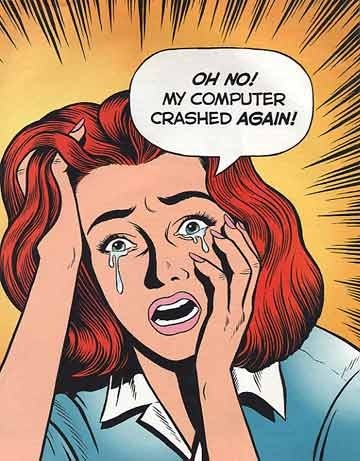
(As usual, what happened is rather inconclusive: laptop went to sleep and didn't "wake up". The nerds from the computer store told me motherboard is dead.)
It's not that this is the first time I've seen a machine kick the bucket (I must have torn to a dozen machines in the last twenty years…) But it's the first time I'm actually writing about it, which brings me to the first point…
1. If Your Machine Crashes, The Net Goes OnTen years ago, when a system crashed and you slowly put the pieces back together or replaced it, you literally had to start out from zero, again. The core of the computing experience, as least as I experienced it back then, was nailed to the physical hardware.
Nowadays, when one system breaks, there's a chance of just continuing seamlessly on another computer and still have access to all your files, contacts, etc in the time it takes to enter a username and password.
Obviously this largely refers to "light-weight" applications such as email and social networking but since Google Docs, even most of the sensitive data stuff like spreadsheets, letters, etc. can be stored in the cloud, so that even someone would go at your system with a hammer, you could just shrug off the broken hardware and continue working on another system as if nothing had happened.
By having my laptop run down the curtain and join the choir invisible, I became aware of how much of my daily user experience is already happening in the cloud. And while it's a big part (I'd say 50+%) it's certainly not all of it.
Most of my creative work still happens offline. And this is where a crash can hurt!
2. Better BackUp Than Be SorryBefore my laptop shuffled off its mortal coil it was so kind to warn me by not waking up as usual. When it finally did came on again, I knew something was fishy so I did a backup immediately of all my manuscripts, pictures and whatnot. (I'm one of these people who know that theoretically backups are a good thing to do but never do them. Having become a bit paranoid after this episode, I found a neat little service called MozyBackup which automatically stores your stuff in the cloud.)
So when it was finally pushing up the daisies and its screen stayed black no matter how tenderly I pushed its power button, I had everything on a harddrive.
Everything that is, except the last 500 words of a yet unpublished short story I was writing shortly before it hopped off the twig.
(The geeks at the store managed to salvage the document, by the way, and it's now finished and awaiting proofreading – more info about this short story series here)
3. Planned Obsolence: It's bound to break, anywayFar from being a conspiracy it's a simple fact that most electronics are built to break down quickly so you'll have to buy another one, soon. There's even a term for it: Planned Obsolescence.
And as my laptop (which had been dutifully carrying its load for about 2 years – they never last longer in my hands) finally bought the farm I jokingly said:
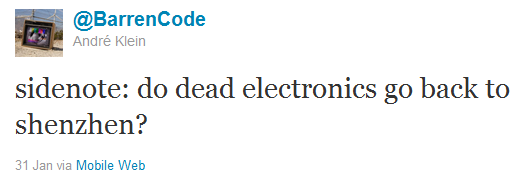
If the name Shenzhen doesn't ring a bell, it's a place in China where most (correction: all) of our electronics are produced. Despite the fact that Apple continues to make headlines with the problems at FoxConn, a factory in Shenzhen, virtually all major electronics companies produce their gadgets in Shenzhen. If you want to find out more about this, listen to this podcast episode here with the title: MR. DAISEY AND THE APPLE FACTORY.
One of my friends, a China specialist responded to the above tweet with the following:
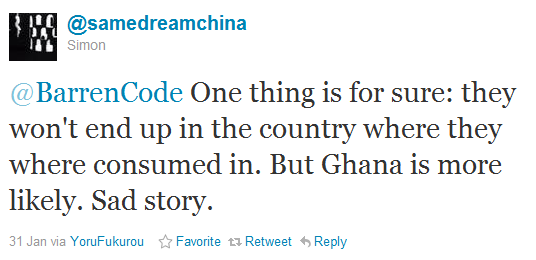
If the name Ghana doesn't ring a bell, either, this is the place where many electronics end up when they perish. Here's a photo gallery of Ghana's Global Graveyard for Dead Computers.
4. Digital Impermanence: Freeing the Message from The MediumInterestingly, one day before my laptop dropped dead I was reading an article by Jonathan Franzen about why he thinks ebooks are bad. Like many others he argues that a book is better because it is made out of paper which is a more durable storage medium.
There's something not quite entirely convincing about this. The ebook critics and digital storage sceptics are everywhere, arguing that in 10 years from now it'll all be gone if we don't start hoarding paper.
When my laptop gave up the ghost I became aware again of how flimsy the connection of an idea is to the material which carries it. There's lots more to say about this, especially in the light of the current copyright disputes (and witch hunts), but I think we have to be careful not to confuse the content with the container.
5. Phantom Pain and Psychological StressLast but not least, it occured to me again how much we as humans are becoming fused with the tools we are using. They become part of us and we become part of them. While on the one hand this "extended nervous system" is a great thing, also our identity is stored and invested in these gadgets. The iPhone has almost replaced the car in terms of status symbols and Apple's success may be largely attributed to the fact that they know how to capitalize on this soft spot of human-machine relationships which are far from neutral and unemotional.
Advertising campaigns are designed to make us feel that we are more with technology, that our gadgets will augment our life. And while I don't want to lament this, I'm always keen to ask who we are without these "identity crutches"?
Are these things really always helping us to be "more connected" and "more productive" or do they actually increasingly shield us from relating to the world in a more direct and wholesome way?
Feel free to leave a comment below!
-
img:

 Some rights reserved by Josh Bozarth
Some rights reserved by Josh Bozarth
~
 About the author:
André Klein has grown up and lived in many places including Germany, Thailand, Sweden and the Middle East. He has taught languages at private schools for many years, produced two music albums, performed at poetry slams, curated an experimental television program and is the author of How To Teach Online Without Selling Your Soul and various other publications.
About the author:
André Klein has grown up and lived in many places including Germany, Thailand, Sweden and the Middle East. He has taught languages at private schools for many years, produced two music albums, performed at poetry slams, curated an experimental television program and is the author of How To Teach Online Without Selling Your Soul and various other publications.
January 29, 2012
Time Management For Freelancers And Power Procrastinators
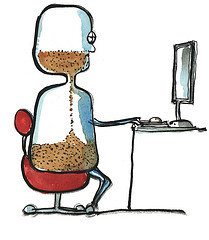 During any given day I do a lot of different things. I'm working on short stories, help people with their WordPress websites and German skills, write blog posts like this one and try to be a normal human being that gets enough fresh air and food.
During any given day I do a lot of different things. I'm working on short stories, help people with their WordPress websites and German skills, write blog posts like this one and try to be a normal human being that gets enough fresh air and food.
Sometimes I joke that the day doesn't have enough hours, the week not enough days and so on and so forth.
But in the end it is all about time management. Especially if you are one of us freelancers or "power procrastinators".
So. Time Management. Sounds like something out of a business seminar or self-help book, right?
To me it did when I first heard about it. And to be quite honest, it still sounds rather dull: Time Management…
In most peoples' minds it brings up associations of discipline, routine and planning. Freelancers want to be free of all of that, don't they?
So, let's see what happens when we get rid of time management altogether..
Manage Your Time, Lest It Manages YouYou start your morning sitting in front of a screen and have a ton of things to do. So you first check your email, see what's new on Twitter, hang around on Facebook a bit and before you know what's happening it's already noon.
By afternoon you still haven't gotten anything done. But you have checked your email and facebook more than twenty times.
You have "so many ideas", so much brilliance locked up inside of you just waiting for a chance to be unleashed, but somehow there's never enough time (!) to get started writing that novel, to work on that song, to write the first few lines of code for that new project.
By the evening, your brain is tired. You look back at the day with a sigh:"If only I would have…" and halfhearted convictions for the next: "Tomorrow everything will be different" while you know that it's probably going to be the same.
The above scenario is an absence of time management and while exaggerated it affects us all to some degree, especially if you're one of us freelancers who can't put the responsibility on someone else's shoulder. Freelancer are their "own boss" but they're also their "own worst nightmare".
What to do? Here are a few time management ideas for freelancers…
A Handful of Tools & Practices For Taming Your TimeHere's a few time management tips that I've found to be helpful:
1. Schedule A Meeting With Yourself
Now, this will sound weird to some people (it certainly does to me) but I've found that if I treat every task in my life like an important business meeting, a date (or any other appointment that I wouldn't miss for all the world) things get a lot easier.
So, when I can't seem to drag myself out of distraction, I go to my calendar and schedule a meeting with myself, let's say: "Writing from 9:00-10:00″) – it's very simple, but it works. And you'll notice that getting started is the hard thing. Once you're in it, you're easily doing more than planned! Plus, the brain releases some of its satisfaction juices once a job is done!
2. Lock It, Block It, Break – Erase It!
If you've scheduled a "meeting with yourself" and you're still checking Email, Facebook etc. it's a sign you're not giving yourself enough credibility. So we're going to need bigger guns. One of them is blocking websites altogether.
I've described one way of doing it here.
3. Destroy The Internet (For a Limited Time)
While I'm happy to say that I've never had to resort to this last option, there's a danger of unblocking temporary blocks of websites for the flimsiest of reasons like needing to "look up that message on Facebook" or "re-reading that article posted on Twitter yesterday".
So, if you're not taking your blocks seriously, use the Uber-Block: DESTROY THE INTERNET…or well, at least block it completely for a specific time.
There's software to help you do that, but you could also just unplug your router for a period that you've agreed upon before.
But remember, freelancers – in the end, there are no magic bullets! And don't worry, we all suffer from it. Here's how Paulo Coelho deals with it, for example.
-

 Some rights reserved by HikingArtist.com
Some rights reserved by HikingArtist.com
About the author:
André Klein has grown up and lived in many places including Germany, Thailand, Sweden and the Middle East. He has taught languages at private schools for many years, produced two music albums, performed at poetry slams, curated an experimental television program and is the author of How To Teach Online Without Selling Your Soul and various other publications.
Free Promo For Authors: Get Listed On Our Bookshelf
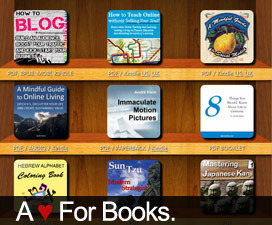
We all know just how hard it is to get your works exposed to a big audience on your own. This is why we launched a little program to give you some extra attention.
more info here
January 24, 2012
How To Get Kindle Feed Subscriptions With Instapaper For Free
Ever since I got a Kindle, I read a lot more. And it turns out that it's not just great for re-reading the old classics or long PDFs I never had the nerve to read on screen, it's also a very convenient way to get my daily dosage of news.
These days, first thing in the morning I turn on my Kindle and read my personalized newspaper, hot off the press.
Here's how (and why) I use a free and customizable way to feed subscriptions to my Kindle every day with Instapaper.
An Avalanche Of 1-Star Reviews: e-Ink ain't Paper
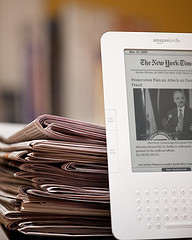
If you take a look at the Kindle store under Newsstand you'll find a lot of bad reviews. At the time of this writing, a subscription of TIME magazine which costs $2.99 per month has 95 reviews, 36 (!) of them only 1 star. Bottom line: almost 38% of reader don't seem happy.
And it's not only TIME. Amazon's Newsweek subscription has 52 reviews, 23 of them outraged. NYT has 91 bad reviews out of 375…
I think a core problem here is that people expect the Kindle subscription to be the same (or very similar) to the paper experience. But what if a Kindle subscription could be something completely different, not just a daily lump from the same editorial board, but a highly customized and personalized newspaper which includes all your favorite blogs, magazines and more?
Kindle Subscriptions: The KindleFeeder WayIf you google the topic you'll immediately stumble over a service called kindlefeeder.com. It allows you to choose from a variety of different feeds and then send them to your Kindle.
At first I was very excited, but then I noticed a few things:
automatic delivery is only for premium users (and there's no other plan than $19 per month)there's no way to share articles to my networks (Twitter, Facebook, etc.)some of the feeds don't display full articles but only snippetssometimes the formatting of the articles was brokenAfter experimenting with this for a few days I decided to look for another way.
A Lean Mean Reading Machine: The Free & Social WayThe heart of this system is Instapaper because it allows you to send automatic updates for free and is wonderfully streamlined for sharing to virtually any social network.
First of all, let me show you a little chart of how I got it set up. Then I'll walk you through the steps:

1. Check if there's a new feed item and if yes, send it to Instapaper
2. Tell Instapaper to automatically send you a collection of your unread articles
3. Read & Share via Instapaper
This is how the process works. Simple, isn't it?
A Step By Step Tutorial1. Sign up for instapaper
Under "Account" click Manage my Kindle Settings

2. Set up Sharing under Account
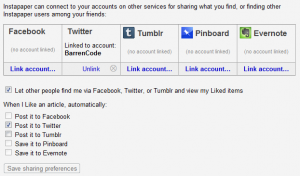
3. Sign up for ifttt.com
4. Activate Instapaper under Channels -> Instapaper (direct link)
5. Use this "Recipe" to set up your first query. (You could also easily create your own, but let's begin with an example)
In our example we will be adding the feed to odditycentral.com. Here's how the recipe looks like:

You can put your own feed where it says "Feed Url" but for example's sake you can also just hit "create task"
5. Repeat the same procedure with different feeds. If the blog/newspaper you want to read on your Kindle doesn't offer full feeds, you might find this little tool here helpful. Simply put the feed URL in there first and then add the url they give you to your ifttt recipe.
6. If you've done everything right, you'll now get your personalized, custom newspaper delivered to your Kindle every morning at 5am.
7. Whenever you read an article you like, hit "LIKE" on your Kindle and it automatically goes to the networks you selected in step 2.
Neat, huh?
-

 Some rights reserved by B.K. Dewey
Some rights reserved by B.K. Dewey
About the author:
André Klein has grown up and lived in many places including Germany, Thailand, Sweden and the Middle East. He has taught languages at private schools for many years, produced two music albums, performed at poetry slams, curated an experimental television program and is the author of How To Teach Online Without Selling Your Soul and various other publications.
January 19, 2012
A Free Short Story About The Middle East

( tl;dr – wrote a short story, you can download it here)
I've lived both in the Far and Middle East. Both experiences left strong memories, traces, impressions. And I noticed very early that if I wanted to convey any of my experiences to others in writing, an autobiographical account wouldn't cut it.
Short Fiction Instead of TraveloguesIt lies in the nature of subjective experience that what to one person is life-changing, to another may be trivial. In other words, the things that leave a strong impression on us are not just very different, they are often intangible, as well.
This is why at the moment I'm working on a series of short stories (and not travelogues!) about the Middle East. On top of that the Middle East as depicted in these writings (you'll find the first short story below) is completely fictional in order to avoid the straight-jacket of preconceived notions and opinions.
Individual Publications For Individual ReadersThese writings will be published independently, that is without the help of publishing houses, marketing and extensive copy-editing. It is an experimental process and whether I'll follow through with the rest of the short stories in this series will depend (to some extent) on how people respond to this idea of a fictionalized Middle East that still contains all its defining characteristics of conflict and contradiction.
What You Get For Downloading This StoryThis first short story is completely free. You'll find the download link at the end of this article.
A few notes:
I arranged it in such a way that by downloading it, you'll get the story in what we call here an "Indie Publishing Pack", meaning a zip file containing a styled PDF, .MOBI file optimized for Kindle and an .EPUB for Sony and other e-readers.
The idea is that if someone downloads an ebook (or short story) he or she should be able to decide on what device and in which way to read it. So, in order to take out the guesswork, you'll get three versions at once.
(If you need help with transferring the files to your device, see also here)
Support Independent PublishingIf you like the story and want more, here's how you can help and support this project by one (or more) of the following ways:
Leave a review on Amazon or SmashwordsPurchase a $0.99 copy on Amazon or Smashwords to help this story reach more readersLeave a comment on this article.Share this article or the story with your friendsSend me a direct message, here.Your responses will determine when the next story comes out and if it published in the same way like this one.
And now *drumroll*, the Download LinkHere it is, the first short story about a fictional Middle East, titled: "Don't Call Me Naomi"
—> click here to go to the download page
About the author: André Klein has grown up and lived in many places including Germany, Thailand, Sweden and the Middle East. He has taught languages at private schools for many years, produced two music albums, performed at poetry slams, curated an experimental television program and is the author of How To Teach Online Without Selling Your Soul and various other publications.
January 13, 2012
How To Skype Better: 5 Tips For Professional and Daily Calls
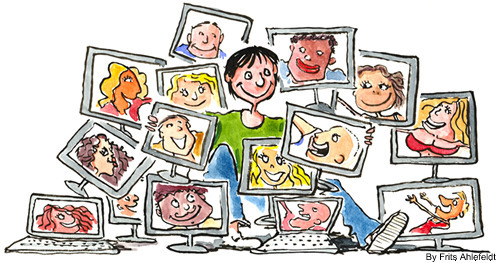
Skype is not just a software. It's a verb. As the Oxford Dictionary informs us, it can be used both with an object "When is a good time to Skype you?" and without as in "We skyped before we met in person."
Skype is a word that is understood by grandmas and expat toddlers all over the world. Chances are it's even more widespread than "to google".
Not so well known is that besides calling family and friends or having cat conferences Skype can be a great business tool for anything from online collaboration and training sessions to reducing phone costs. It is (not only) for these professional users that the following tips will be interesting.
1. Quick MuteDescription: Quickly mute your microphone by hitting a combination on your keyboard
Benefits: Danger of sudden background noise such as a sneeze, car alarm or ringing phone? Need to talk to someone beside you while in a professional conversation? Hitting mute will spare your caller the distraction and protect your privacy at the same time. The best thing is that these hotkeys work even when the Skype window is not in focus, meaning it will work even when the call is running in the background. (Of all these tips, this is what I use the most)
How To:
Go to Tools -> Options -> Advanced -> Hotkeys
Make sure Hotkeys in general, and the Mute function in particular are enabled.
Choose a combination. Finished.
(I chose Alt+Space because the keys are directly next to one another and I can easily mute/unmute with one hand)
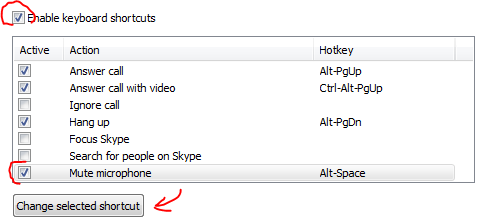
2. Disable IM Sounds
Description: When you get a lot of instant messages or simply use this function daily, these "plop" sounds can be very annoying, especially with headsets, especially if it is for some reason too loud and a tiny IM shoots directly through your skull.
Benefit: One of the best tips to curb distraction and preserve sanity: disable IM sounds.
How To:
Go to Tools -> Options -> Notifications -> Sounds
remove the tick where it says "incoming IM"
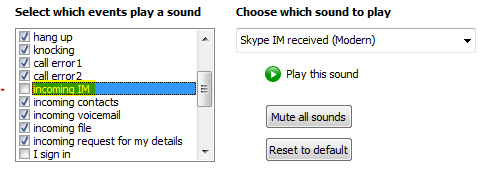
Description: Whenever one of the people on your contact list goes online, Skype will tell you by popping up little window on your screen, even if you're doing something completely different at the time, such as writing a blog post or trying to figure out where your money went that month. If you have a long contact list with a lot of users, you'll see a lot of these notifications. Most of the time they aren't relevant. Also, whenever someone experiences connection instabilities he will "flicker" and you'll see these messages popping on and off.
Benefit: Clear your headspace! Remove them!
How To:
Go to Tools -> Options -> Notifications -> Notification Settings
Remove the tick where it says "comes online"

Description: Use Skype to reach mobile phones and landlines
Benefits: Very cheap, good cost control and you have your phone book with you whenever you log in somewhere else.
How To:
Simply dial a number anywhere on the planet (Skype will help you to find the right prefix)
Skype will tell you to upload funds to your account. Yep, it's not free, but still very affordable and convenient. I never use anything else anymore to make international phone calls.
5. Call ForwardingDescription: Forward your Skype calls to your mobile phone
Benefit: Receive Skype calls even when away from computer and offline.
How To:
Go to Tools -> Options -> Calls -> Call Forwarding

Note: You have to pay for this feature. Standard rates apply.
-
Did you like these tips? Here are some more…
Even More TipsSet up your personal Skype wake-up call
Run Two Instances Of Skype Simultaneously
Build Your Own Call Center with Skype
-
What tips do you use? Leave a comment below!
-
img: 
 Some rights reserved by HikingArtist.com
Some rights reserved by HikingArtist.com
About the author:
André Klein has grown up and lived in many places including Germany, Thailand, Sweden and the Middle East. He has taught languages at private schools for many years, produced two music albums, performed at poetry slams, curated an experimental television program and is the author of How To Teach Online Without Selling Your Soul and various other publications.
January 11, 2012
Tons Of Kindle Screensaver Fun And Creative Wallpaper Resources

Some of us have learned to love the screensaver images Amazon ships with their Kindle reading devices. Others quietly suffer the rotating selection of dead poets and educational images of fishes and plants. And yet others simply ask: "What if I'd like to see something else?"
Personally, I belong to the third category. I was neither particularly thrilled nor appalled by the Kindle stock wallpapers of Emily Dickinson, Mark Twain and others. But, as so often, a little innocent question led me down a rabbit hole of business interests, hacks and limitless creativity.
So, in case you're wondering. The answer is NO! You can't change the screensaver on your Kindle. At least Amazon doesn't want you to do it. Why? The answer to this question is a bit more complicated, but I've read on forums that earlier Kindles ( I think it was V2) actually had an option to choose custom screensaver images but Amazon scrapped it because newer Kindles used this feature to rotate advertisements.
Warning Notices and Re-Claiming eReading TurfFortunately, that's not the end of this story. Thanks to inquisitive individuals all over the world, there's now a relatively danger-free way of re-configuring your Kindle so that it will allow you to choose custom screensaver or wallpaper pictures.
Compared to "unjailing" iPhones, there's allegedly little danger of "bricking" (destroying) your Kindle this way, and the providers of the hack even offer packages to uninstall and reverse any changes you may have made, but it does require a bit of willingness to experiment.
If you want to do it, here's a link to a detailed tutorial. At the top it says "WARNING: Use at your own risk! ""
At first I was sceptical, too. But never underestimate the power of an innocent question. So, finally, I threw "caution" to the wind, it worked without problems, and I never missed Amazon's Twains and Dickinsons. Instead, I now choose whatever I want to see, just like selecting a wallpaper on any other device I own.
Where To Get Alternative Screensaver Pictures FromKeep in mind that the best format for a Kindle wallpaper is 600×800 pixels and the e-ink doesn't display color so you might as well select something grayscale from the start.
The easiest way to find suitable, ready-made Kindle wallpaper material is to browse collections.
Online Collections
Stylish, minimalist collection.
contains some great ones!
note: there are other collections, but I've found them wanting.
Browse & Crawl
If you've exhausted all collections so far or couldn't find anything you like, here's four other ways:
1. Do a FlickR search!

2. Browse Tumblr for everything that was ever tagged with "kindle wallpaper"
3. Look at /r/kindlescreensavers/ on Reddit.
4. my personal favourite: use Google image search and set image size to "exactly" -> 600 x 800 px and color to -> "black & white" (see screenshot)

Make Your Own
If all of the above still isn't enough, be creative and make your own! Tip: Use a service like www.picresize.com to transform your snapshots into the right dimensions.
What's Your Favourite Source For Kindle Screensavers? Leave a comment below!
-
img:

 Some rights reserved by WheresWilson
Some rights reserved by WheresWilson
About the author:
André Klein has grown up and lived in many places including Germany, Thailand, Sweden and the Middle East. He has taught languages at private schools for many years, produced two music albums, performed at poetry slams, curated an experimental television program and is the author of How To Teach Online Without Selling Your Soul and various other publications.




